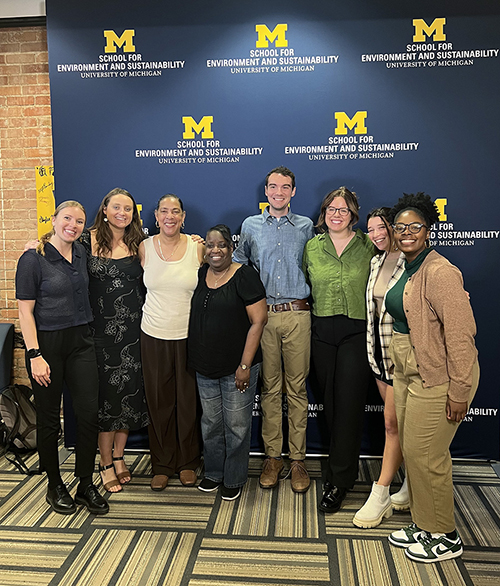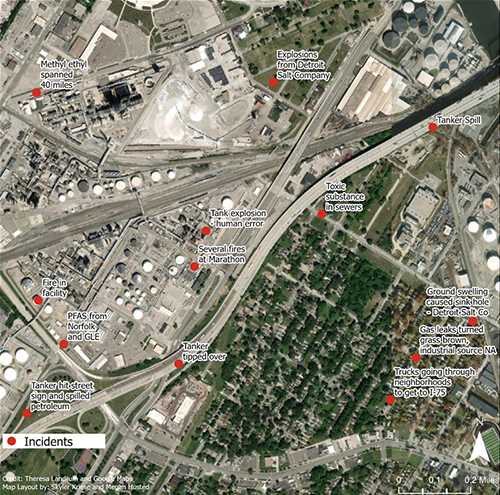
Mapping Environmental Justice and Uplifting Community Survival in Southwest Detroit
Unhealthy air quality created by smoke from the Canadian wildfires has been a topic of concern across Michigan and much of the U.S. lately. But for residents of the 48217 community in Southwest Detroit, known as the most polluted ZIP code in Michigan, breathing toxic air has been their daily experience for decades.
A group of University of Michigan School for Environment and Sustainability (SEAS) graduates sought to bring awareness to 48217 and its environmental burdens through their master’s project, “Mapping Environmental Justice and Uplifting Community Survival in Southwest Detroit.”
The team—which includes Dinah George (MS ’23), Megan Husted (MS ’23), Anna Bunting (MS ’23), John McClure (MS ’23), and Skyler Kriese (MS ’23)—recently presented their findings at the Michigan Environmental Justice Conference in Detroit.

Their project, which was done on behalf of the Michigan Department of Environment, Great Lakes, and Energy’s (EGLE) Office of Environmental Justice Public Advocate, included creating additional data layers for MiEJScreen, the Michigan Environmental Justice Screening Tool, along with a community resilience plan for 48217, a historically Black community that is low-income and has disproportionately high rates of respiratory problems, asthma, cancer and heart disease that are linked to air pollution.
“48217 is a vibrant community that is in close proximity to a lot of pollution that oftentimes is the only thing people focus on,” said George. “It’s also a community that has suffered from historic and racial disinvestment, which is why residents are experiencing the realities of environmental injustice.”
Part of the Tri-Cities area that includes Ecorse and River Rouge, 48217 received its “most polluted” moniker because the area is surrounded by 42 industrial facilities that release hazardous chemicals, such as sulfur dioxide and benzene, into the air.
Among them are the Marathon Petroleum refinery, DTE Energy, AK Steel, a hydrogen power plant, and the nation’s largest wastewater treatment plant. These facilities loom large in the background of homes, playgrounds, churches, and schools—visible from almost anywhere in 48217.
The 48217 community also experiences increased traffic from industrial trucks that cut through residential neighborhoods to shorten their routes to highways and bridges to Canada, exposing residents to increased emissions.
“One of our key takeaways from working with the 48217 community is how strong, passionate, and inspiring they are,” said McClure. “Something we wanted to stress in our project is that the residents of 48217 are survivors. They are continually being poisoned by industrial pollution, but they’re actively working every day for their families, neighbors, and loved ones, so that they not only survive in their environment, but also thrive.”
The students—who all specialized in environmental justice at SEAS—used a mixed-methods approach for their master’s project, which included interviewing 48217 residents about changes to their area over time; collecting data and mapping where environmental injustice incidents occurred, such as tanker spills, fires, and gas leaks; and creating recommendations for the community in the areas of industry and regulation, health, and survival.
Environmental justice expert and SEAS Professor Paul Mohai connected the students with longtime 48217 community activists Theresa Landrum, Rhonda Anderson and Dolores Leonard, who served as the students’ collaborators for a year and a half and provided guidance for the project that was crucial to its success, George said.
Acting as the students’ community advisory board, the activists took the students on a “toxic tour” of 48217, where they saw “one polluting industry after another,” with many located on the same street. They also facilitated interviews between the students and residents and shared important history about the area, including providing an understanding of how the community’s assets, such as churches, parks, and its recreation center, make up the social fabric of 48217 and serve as important hubs for engagement, kinship, and support.
“We tried to approach our project in a community-centered way, making sure we met regularly with our community advisory board not only to update them but to work with them on our project,” George said. “We met more frequently with our community advisors than we did our actual client, EGLE.”
An important component of the master’s project is a story map created using ArcGIS software that includes a community narrative with the residents’ perspectives and insights, from how long they have lived in 48217 and what parts of the community are important to them, to their recollections of how specific environmental incidents impacted them personally.
The qualitative data in the story map, which also includes photos, maps, and graphs, supplement the quantitative data compiled in the EJ screening tool and provide a richer understanding of how environmental injustices have compounded over time in 48217 and resulted in cumulative health impacts, Kriese noted.
“What’s incredible to me is the lack of knowledge throughout all of Michigan and the United States of just how badly this community is being violated,” Kriese said. “A lot of people have no idea of how bad the pollution is in 48217, and the exploitation of lives that is taking place there. The life expectancy is 10 years lower in 48217 than in surrounding areas.

“And yet it’s also powerful to me the advocacy and activism that’s being sustained by Theresa Landrum, Rhonda Anderson and Dolores Leonard, and their friends and family, who bring attention to their injustices on a daily basis.”
The students hoped to elevate the work of these activists and bring wider attention to 48217 by presenting their master’s project at the Michigan Environmental Justice Conference. It was a great networking opportunity, the students said, and has resulted in invitations to do additional presentations and collaborations with other environmental groups, including the U.S. Environmental Protection Agency. The students also want to publish their research in a journal so it can be replicated in states outside of Michigan.
“It was an invaluable and powerful experience getting to share our project with a broader audience,” said Husted. “It was well received, and it got people talking about what the next steps for the project are, which I am hoping will turn into momentum for creating real change.
“I also think the project was able to push people to think critically about the use of EJ screening tools because they are relatively new. Screening tools should not be used just to identify EJ communities, but for regulators and polluters alike to be able to identify where they have failed communities across the state.”
Ember McCoy (MS ’17), a PhD student at SEAS who is studying Resource Policy and Behavior, served as the academic advisor for the 48217 master’s project. In addition to Environmental Justice, Anna Bunting specialized in Sustainability and Development and Megan Husted and John McClure specialized in Environmental Policy and Planning. McClure also earned an STPP (Science, Technology, and Public Policy) Graduate Certificate from U-M’s Ford School.
More Information
Master’s project report: Mapping Environmental Justice and Uplifting Community Survival in Southwest Detroit.”
ArcGIS story map: Stories of the 48217 Community

